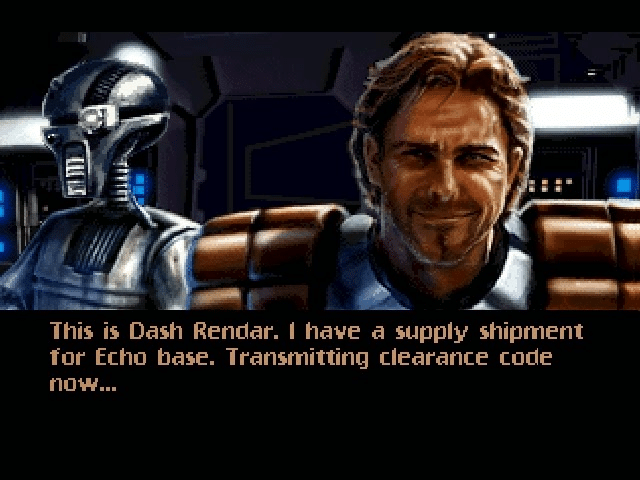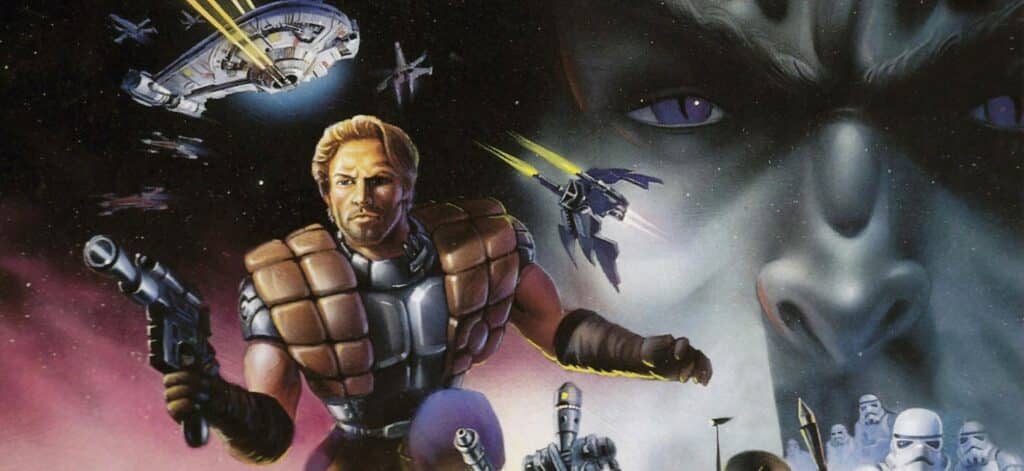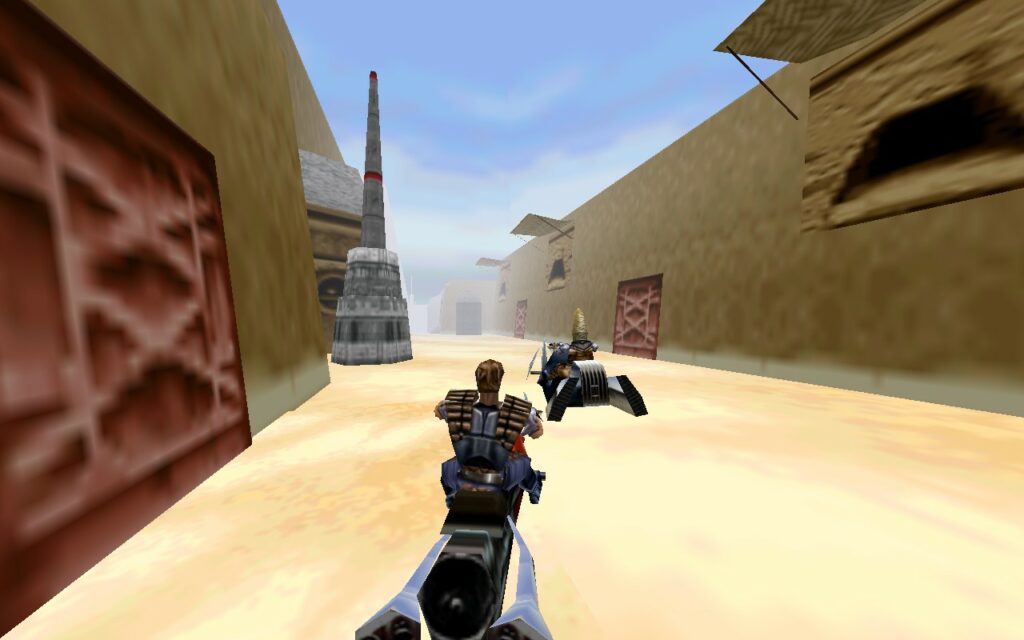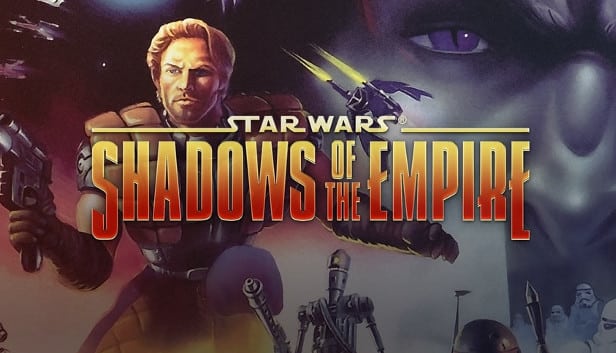Twenty-seven years ago, the gaming world witnessed the launch of a title that would become a cornerstone in the Star Wars gaming legacy. “Star Wars: Shadows of the Empire,” released on the Nintendo 64, not only captivated fans with its immersive gameplay but also enriched the Star Wars narrative in a way few games had done before. As we celebrate its 27th anniversary, let’s take a moment to reflect on the enduring impact of this iconic game.

Key Highlights of the Story:
- The Emergence of a New Hero: Introduction of Dash Rendar, a character who became an instant favorite among the Star Wars community.
- Genre-Blending Gameplay: A unique combination of space combat, third-person shooting, and adventure elements that offered a diverse gaming experience.
- Narrative Bridge Between Films: Filling the narrative gap between “The Empire Strikes Back” and “Return of the Jedi,” adding depth to the Star Wars saga.
- LucasArts’ Creative Milestone: Showcasing the innovation and storytelling prowess of LucasArts, setting a benchmark for future Star Wars games.
- Enduring Legacy: The game’s lasting impact on the Star Wars franchise and its role in shaping the future of Star Wars video games.
Introduction: A Nostalgic Leap into a Galaxy Far, Far Away
Twenty-seven years ago, a game was released that would leave an indelible mark on the Star Wars gaming universe and the hearts of countless fans. “Star Wars: Shadows of the Empire,” developed by LucasArts, made its grand debut on the Nintendo 64, introducing players to an experience that bridged the gap between two iconic films in the Star Wars saga.
Dash Rendar – A New Hero in a Familiar Galaxy
When “Star Wars: Shadows of the Empire” hit the shelves, it brought with it a new character who would quickly capture the hearts of Star Wars fans: Dash Rendar. His introduction marked a significant moment in the Star Wars universe, offering players a fresh perspective within a familiar setting.
The Creation of Dash Rendar
- Design and Concept: Dash Rendar was designed to fit seamlessly into the Star Wars universe. His character was crafted to embody the rogue charm similar to Han Solo, yet with distinct traits that set him apart. His iconic shoulder pads and rugged appearance gave him a unique visual identity that resonated with players.
- Narrative Role: Rendar’s role in the game was pivotal. Set in the timeline gap between “The Empire Strikes Back” and “Return of the Jedi,” he provided a new lens through which fans could experience the Star Wars saga. His storyline intertwined with key events and characters, enriching the overarching narrative.
Dash Rendar’s Impact on Players
- Player Connection: Players were drawn to Dash’s charisma and complexity. He wasn’t just a stand-in for the more well-known heroes of the franchise; he was a fully realized character with his own motivations, strengths, and flaws.
- Gameplay Experience: Through Dash, players could explore various aspects of the Star Wars universe, from piloting the Outrider to engaging in on-foot combat. His versatility as a character allowed for diverse gameplay experiences.
Expanding the Star Wars Universe
- New Adventures: Dash Rendar allowed LucasArts to explore new stories within the Star Wars universe. His adventures filled in narrative gaps and added depth to the existing lore, making “Shadows of the Empire” a significant expansion of the Star Wars universe.
- Legacy in Star Wars Lore: While Dash Rendar is part of the ‘Legends’ non-canon storyline, his impact on the franchise is undeniable. He represents the potential of video games to contribute meaningfully to the broader narrative of a beloved universe.
Cultural Significance
- Fan Reception: The character of Dash Rendar was met with enthusiasm by fans, who appreciated the fresh yet respectful addition to the Star Wars roster. His presence demonstrated the franchise’s ability to evolve and expand while staying true to its roots.
- Influence on Future Characters: Dash’s success paved the way for future characters in the Star Wars universe, showing that new heroes could stand alongside the iconic figures of Luke Skywalker, Han Solo, and Princess Leia.
In conclusion, Dash Rendar’s introduction in “Star Wars: Shadows of the Empire” was more than just the addition of a new character; it was a bold step in expanding the Star Wars universe. His journey offered a new perspective on familiar events and demonstrated the potential of video games as a medium for storytelling within the Star Wars saga.

A Diverse Gameplay Experience
“Star Wars: Shadows of the Empire” stood out in the realm of video gaming for its innovative and diverse gameplay experience. This chapter wasn’t just about introducing a new character in Dash Rendar; it was about immersing players in a multifaceted world that captured the essence of the Star Wars universe through various gameplay styles.
Blending Multiple Genres
- Genre Fusion: The game was a trailblazer in combining different gaming genres. It seamlessly integrated elements of third-person shooting, space combat, and adventure gameplay, offering a rich and varied experience.
- Impact on Player Engagement: This fusion of genres kept players constantly engaged, as they had to adapt to different styles of play. From piloting the Outrider in intense space battles to engaging in on-foot combat missions, the game ensured a fresh experience at every turn.
Space Combat and Flight Simulation
- Innovative Flight Mechanics: One of the game’s highlights was its space combat sequences. These segments were not just about shooting down enemy ships; they involved strategic maneuvering and skillful piloting, capturing the thrill of Star Wars space battles.
- Immersive Environments: The game’s flight segments were set against the backdrop of beautifully rendered space environments, complete with asteroid fields and enemy capital ships, enhancing the authenticity of the experience.
Third-Person Shooting and Exploration
- On-Foot Missions: When not in the cockpit, players experienced the game from a third-person perspective, engaging in ground missions that involved exploration, combat, and puzzle-solving.
- Varied Environments: These missions took players to different locations within the Star Wars universe, each with its unique challenges and aesthetics, from the icy plains of Hoth to the streets of Mos Eisley.
The Role of Puzzles and Strategy
- Intellectual Challenges: Beyond combat and piloting, “Shadows of the Empire” incorporated puzzles and strategic elements, requiring players to think critically and plan their moves, adding depth to the gameplay.
- Integration with the Story: These puzzles were not standalone challenges; they were woven into the narrative, making them integral to the progression of the story and the development of the character.
Customization and Progression
- Character Development: As players progressed through the game, they had opportunities to upgrade Dash’s abilities and arsenal, tailoring their gameplay experience to their style.
- Replay Value: The variety in gameplay, coupled with character progression, gave “Shadows of the Empire” a high replay value. Players could revisit the game and experience different aspects of gameplay in new ways.
In summary, the diverse gameplay experience of “Star Wars: Shadows of the Empire” was a significant factor in its success and enduring appeal. By blending multiple genres and offering a variety of challenges, the game not only provided an engaging experience but also set a precedent for future titles in the Star Wars gaming franchise.
Bridging the Gap Between Films
Star Wars: Shadows of the Empire” played a crucial role in the Star Wars saga by filling in narrative gaps between “The Empire Strikes Back” and “Return of the Jedi.” This chapter of the game was not just a filler; it was a well-crafted story that added depth and context to the overarching narrative of the Star Wars universe.
Enhancing the Star Wars Lore
- Storytelling Excellence: The game excelled in storytelling, weaving a tale that fit seamlessly into the existing Star Wars timeline. It provided background stories and expanded on events that were only briefly touched upon in the movies.
- Character Integration: Key characters from the films were integrated into the game’s storyline, maintaining continuity and authenticity. This integration allowed players to see different sides of these beloved characters and understand their actions and motivations during this period.
The Role of Dash Rendar
- Connecting Dots: Dash Rendar’s journey intersected with pivotal events and characters from the films, providing a fresh perspective on familiar scenes and adding new layers to the story.
- New Insights: Through Dash’s eyes, players gained insights into the Rebel Alliance’s struggles, the Empire’s machinations, and the dynamics of the Star Wars galaxy during a critical period.
Expanding the Universe
- New Settings and Scenarios: The game introduced new locations and scenarios, enriching the Star Wars universe. These additions were not just visually appealing but also narratively significant, contributing to the depth of the world.
- Cultural Impact: By bridging the gap between the films, “Shadows of the Empire” influenced the broader Star Wars culture, inspiring books, comics, and fan theories that explored this period in even greater detail.
Contribution to Star Wars Canon
- Legends Status: While “Shadows of the Empire” is part of the Star Wars ‘Legends’ and not the official canon, its influence on the franchise is undeniable. It set a precedent for how video games could contribute to the Star Wars narrative.
- Fan Acceptance: The game’s story was widely accepted and loved by fans, becoming a beloved part of the Star Wars legacy. It showed that the universe could be expanded in meaningful ways through different mediums.
Legacy in Storytelling
- Innovative Narrative Approach: The game’s approach to storytelling was innovative for its time, showing that video games could be more than just action and adventure; they could also be a medium for complex storytelling.
- Influence on Future Titles: The success of “Shadows of the Empire” in bridging film narratives influenced future Star Wars games and other media, encouraging them to explore untold stories within the Star Wars universe.
In conclusion, “Star Wars: Shadows of the Empire” was more than just a game; it was a narrative bridge between two iconic films. Its contribution to the Star Wars saga was significant, providing fans with a deeper understanding of the events that shaped the galaxy far, far away. The game’s ability to weave a compelling story that complemented the films was a testament to its creators’ understanding and respect for the Star Wars universe.

The Legacy of Shadows of the Empire
“Star Wars: Shadows of the Empire” stands as a monumental title in the realm of video gaming, particularly within the Star Wars franchise. Its legacy extends far beyond its initial release on the Nintendo 64, continuing to influence the Star Wars universe and the gaming industry.
Pioneering Storytelling in Gaming
- Narrative Benchmark: The game set a high benchmark for storytelling in video games. Its ability to tell a compelling story within the Star Wars universe while introducing new characters and plots was groundbreaking.
- Inspiration for Future Games: The success of “Shadows of the Empire” in narrative storytelling inspired future game developers to focus more on story-driven gameplay, particularly in the Star Wars franchise.
Impact on the Star Wars Expanded Universe
- Expanding the Lore: The game played a significant role in expanding the Star Wars Expanded Universe (now known as ‘Legends’). It introduced new elements that were later explored in novels, comics, and other media.
- Cultivating a Richer Universe: By adding depth to the time between “The Empire Strikes Back” and “Return of the Jedi,” the game contributed to a richer, more detailed Star Wars universe, offering fans more content to explore.
Technological Innovations
- Advancements in Game Design: “Shadows of the Empire” was notable for its technological innovations in game design and graphics. It pushed the boundaries of what was possible on the Nintendo 64, setting a standard for future games in terms of visual and gameplay design.
- Influence on Game Mechanics: The game’s blend of different gameplay styles influenced the development of future action-adventure games, showing the potential of combining various gaming mechanics in a single title.
Cult Status Among Fans
- Enduring Fan Love: The game has achieved a cult status among Star Wars fans and gamers. Its unique story and gameplay continue to be celebrated and remembered fondly, even decades after its release.
- Community and Fan Content: “Shadows of the Empire” has inspired a wealth of fan content, including art, fan fiction, and community discussions, further cementing its place in Star Wars lore.
Legacy in Modern Star Wars Media
- Influence on New Star Wars Projects: Elements from “Shadows of the Empire” have influenced modern Star Wars projects, with creators drawing inspiration from its characters, storylines, and settings.
- Recognition in Star Wars History: The game is often cited in discussions about the history and evolution of Star Wars video games, recognized for its contribution to the broader narrative of the franchise.
Educational Value
- Teaching Tool for Narrative Design: “Shadows of the Empire” is sometimes used as a case study in game design and storytelling courses, teaching new generations of game designers about effective narrative integration in video games.
In summary, the legacy of “Star Wars: Shadows of the Empire” is multifaceted, spanning technological innovation, storytelling, expansion of the Star Wars universe, and enduring fan engagement. Its impact is evident not only in the realm of gaming but also in the broader context of Star Wars media and storytelling. As a pioneering title in the franchise, it set a precedent for how games could expand and enrich a beloved universe like Star Wars.

Conclusion: A Timeless Classic in Star Wars Gaming
As we look back on the 27th anniversary of “Star Wars: Shadows of the Empire,” it’s clear that the game was more than just a title for the Nintendo 64 – it was a pivotal moment in Star Wars gaming history. It captured the imagination of a generation and offered a unique way to experience the galaxy far, far away. For many, “Shadows of the Empire” remains a beloved classic, a game that not only entertained but also expanded the boundaries of what a Star Wars game could be.
FAQ: Star Wars: Shadows of the Empire on Nintendo 64
Q1: What is ‘Star Wars: Shadows of the Empire’? A1: ‘Star Wars: Shadows of the Empire’ is a video game developed by LucasArts, released in 1996 for the Nintendo 64. It’s an action-adventure game set in the Star Wars universe, between the events of ‘The Empire Strikes Back’ and ‘Return of the Jedi.
Q2: Who is the main character in the game? A2: The game introduces a new character, Dash Rendar, a mercenary and pilot who becomes a key figure in the Star Wars narrative during the events between the two films.
Q3: What types of gameplay does ‘Shadows of the Empire’ offer? A3: The game features a mix of different gameplay styles, including third-person shooting, space combat, and flying missions. It’s known for its variety and immersive Star Wars experience.
Q4: Did ‘Shadows of the Empire’ contribute to the Star Wars storyline? A4: Yes, the game expanded the Star Wars universe by exploring events and characters not covered in the films. It played a significant role in bridging the gap between ‘The Empire Strikes Back’ and ‘Return of the Jedi’.
Q5: Is Dash Rendar part of the official Star Wars canon? A5: Dash Rendar was part of the Star Wars Expanded Universe, which has since been rebranded as ‘Legends’ by Lucasfilm. While not part of the official canon, he remains a beloved character among fans.
Q6: What makes ‘Shadows of the Empire’ unique among Star Wars games? A6: Its innovative blend of gameplay styles, compelling storyline, and introduction of new elements to the Star Wars lore make it stand out. It was also one of the first major Star Wars games released on the Nintendo 64.
Q7: How was the game received upon release? A7: ‘Shadows of the Empire’ was generally well-received, praised for its ambitious scope and engaging gameplay. It has since become a cult classic among Star Wars and video game enthusiasts.
Q8: Can ‘Shadows of the Empire’ still be played today? A8: Yes, the game can be played on the original Nintendo 64 console. It’s also available on modern platforms through various re-releases and emulation.
Q9: Did ‘Shadows of the Empire’ have any impact on future Star Wars games? A9: Yes, it influenced the development of future Star Wars games, particularly in terms of narrative depth and integrating diverse gameplay mechanics.
Q10: Are there any sequels or follow-ups to ‘Shadows of the Empire’? A10: While there’s no direct sequel to the game, the character of Dash Rendar and elements of the story have appeared in other Star Wars media, including books and comics.



